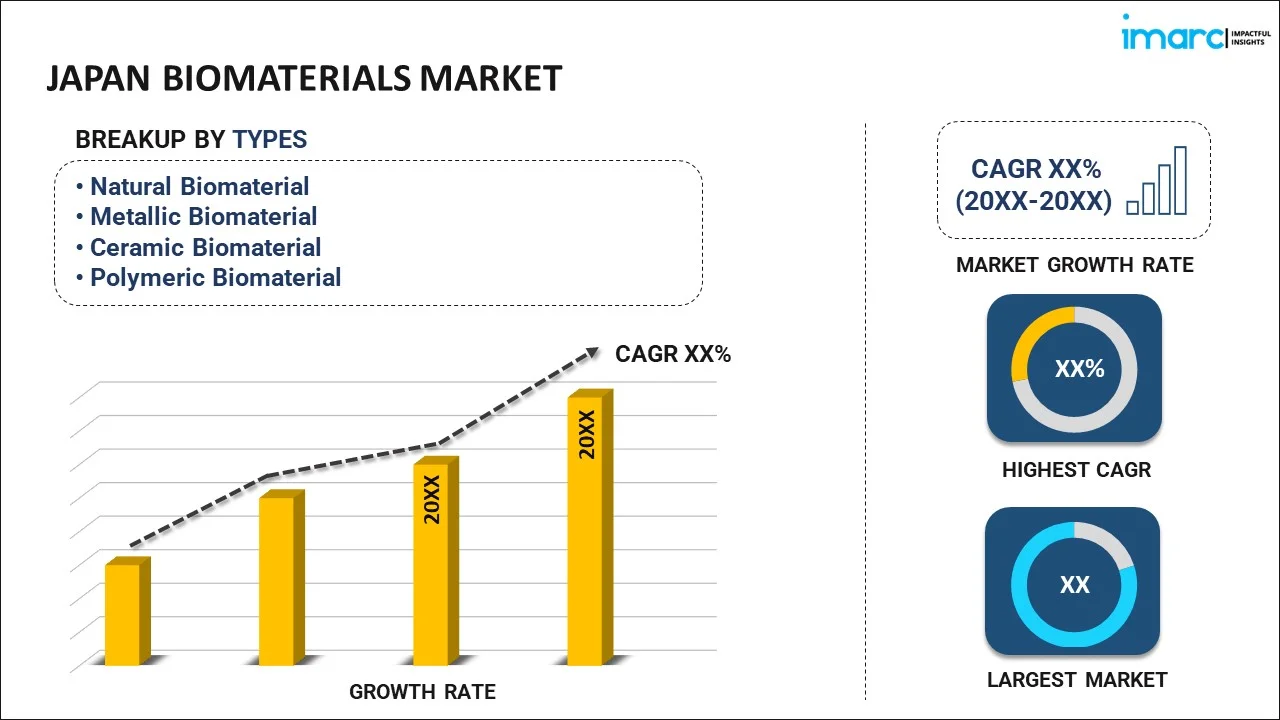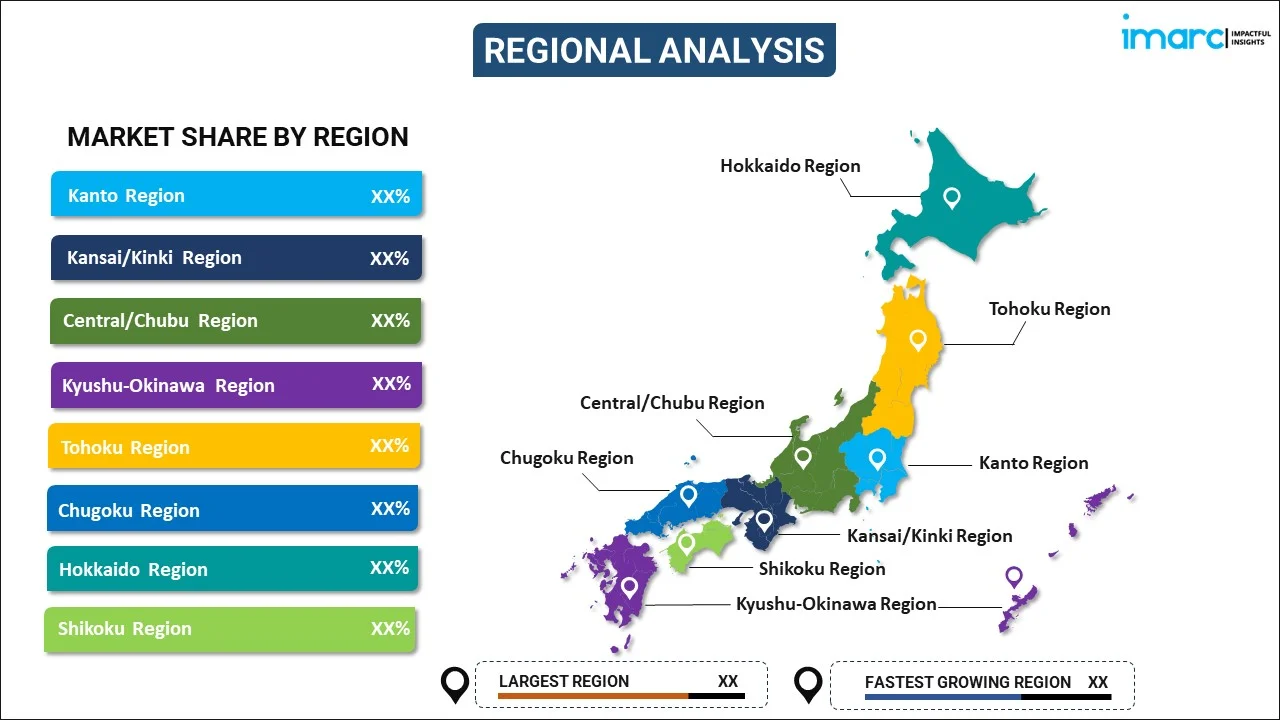
Japan Biomaterials Market Report by Type (Natural Biomaterial, Metallic Biomaterial, Ceramic Biomaterial, Polymeric Biomaterial), Application (Neurology, Cardiology, Orthopedics, Wound Care, Dental, Plastic Surgery, and Others), and Region 2025-2033
Market Overview:
Japan biomaterials market size reached USD 7,458 Million in 2024. Looking forward, IMARC Group expects the market to reach USD 20,697 Million by 2033, exhibiting a growth rate (CAGR) of 12% during 2025-2033. The rising cases of chronic ailments, such as cardiovascular diseases, diabetes, and orthopedic disorders, and the increasing need for biomaterial-based medical devices and therapies, are primarily driving the market.
|
Report Attribute
|
Key Statistics
|
|---|---|
|
Base Year
|
2024
|
|
Forecast Years
|
2025-2033
|
|
Historical Years
|
2019-2024
|
| Market Size in 2024 | USD 7,458 Million |
| Market Forecast in 2033 | USD 20,697 Million |
| Market Growth Rate 2025-2033 | 12% |
Biomaterials are substances designed and engineered to interact with biological systems, often for medical or therapeutic purposes. These materials are used in a variety of applications, from artificial organs and tissue engineering to drug delivery systems and medical implants. Biomaterials can be natural, synthetic, or a combination of both, and they are carefully selected based on their compatibility with the human body. Natural biomaterials, such as collagen and silk, are derived from biological sources and are known for their biocompatibility. Synthetic biomaterials, like polymers and ceramics, are tailored for specific properties like strength and durability. The choice of biomaterial depends on the intended function and location within the body. Biomaterials play a crucial role in modern medicine, enabling advancements in treatments and procedures. They can promote tissue regeneration, provide structural support, and serve as carriers for therapeutic agents. However, ensuring their safety and effectiveness is paramount, as they must not elicit harmful immune responses or adverse reactions when introduced into the body. Researchers continually innovate in the field of biomaterials to enhance medical treatments and improve patient outcomes.
Japan Biomaterials Market Trends:
The biomaterials market in Japan is witnessing robust growth, primarily driven by several interconnected factors. Firstly, the increasing cases of chronic diseases such as cardiovascular disorders and orthopedic ailments have propelled the demand for biomaterials in the medical field. Furthermore, an aging regional population is contributing to this trend, as older individuals require more medical interventions that often involve biomaterials. Secondly, technological advancements have significantly enhanced the versatility and effectiveness of biomaterials. This is exemplified by the development of bioactive ceramics, biodegradable polymers, and tissue engineering techniques, which have expanded the scope of biomaterial applications. Thirdly, the growing awareness of the environmental impact of traditional materials has led to a surge in demand for sustainable biomaterials. As consumers become more eco-conscious, biomaterials made from renewable sources, like plant-based polymers, gain traction in various industries, including packaging and automotive. Lastly, numerous government initiatives and regulations that are promoting the use of biomaterials for medical and industrial purposes, are expected to drive the biomaterials market in Japan during the forecast period.
Japan Biomaterials Market Segmentation:
IMARC Group provides an analysis of the key trends in each segment of the market, along with forecasts at the country level for 2025-2033. Our report has categorized the market based on type and application.
Type Insights:

- Natural Biomaterial
- Metallic Biomaterial
- Ceramic Biomaterial
- Polymeric Biomaterial
The report has provided a detailed breakup and analysis of the market based on the type. This includes natural biomaterial, metallic biomaterial, ceramic biomaterial, and polymeric biomaterial.
Application Insights:
- Neurology
- Cardiology
- Orthopedics
- Wound Care
- Dental
- Plastic Surgery
- Others
A detailed breakup and analysis of the market based on the application have also been provided in the report. This includes neurology, cardiology, orthopedics, wound care, dental, plastic surgery, and others.
Regional Insights:

- Kanto Region
- Kansai/Kinki Region
- Central/ Chubu Region
- Kyushu-Okinawa Region
- Tohoku Region
- Chugoku Region
- Hokkaido Region
- Shikoku Region
The report has also provided a comprehensive analysis of all the major regional markets, which include Kanto Region, Kansai/Kinki Region, Central/ Chubu Region, Kyushu-Okinawa Region, Tohoku Region, Chugoku Region, Hokkaido Region, and Shikoku Region.
Competitive Landscape:
The market research report has also provided a comprehensive analysis of the competitive landscape in the market. Competitive analysis such as market structure, key player positioning, top winning strategies, competitive dashboard, and company evaluation quadrant has been covered in the report. Also, detailed profiles of all major companies have been provided.
Japan Biomaterials Market Report Coverage:
| Report Features | Details |
|---|---|
| Base Year of the Analysis | 2024 |
| Historical Period | 2019-2024 |
| Forecast Period | 2025-2033 |
| Units | Million USD |
| Scope of the Report | Exploration of Historical and Forecast Trends, Industry Catalysts and Challenges, Segment-Wise Historical and Predictive Market Assessment:
|
| Types Covered | Natural Biomaterial, Metallic Biomaterial, Ceramic Biomaterial, Polymeric Biomaterial |
| Applications Covered | Neurology, Cardiology, Orthopedics, Wound Care, Dental, Plastic Surgery, Others |
| Regions Covered | Kanto Region, Kansai/Kinki Region, Central/ Chubu Region, Kyushu-Okinawa Region, Tohoku Region, Chugoku Region, Hokkaido Region, Shikoku Region |
| Customization Scope | 10% Free Customization |
| Post-Sale Analyst Support | 10-12 Weeks |
| Delivery Format | PDF and Excel through Email (We can also provide the editable version of the report in PPT/Word format on special request) |
Key Questions Answered in This Report:
- How has the Japan biomaterials market performed so far and how will it perform in the coming years?
- What has been the impact of COVID-19 on the Japan biomaterials market?
- What is the breakup of the Japan biomaterials market on the basis of type?
- What is the breakup of the Japan biomaterials market on the basis of application?
- What are the various stages in the value chain of the Japan biomaterials market?
- What are the key driving factors and challenges in the Japan biomaterials?
- What is the structure of the Japan biomaterials market and who are the key players?
- What is the degree of competition in the Japan biomaterials market?
Key Benefits for Stakeholders:
- IMARC’s industry report offers a comprehensive quantitative analysis of various market segments, historical and current market trends, market forecasts, and dynamics of the Japan biomaterials market from 2019-2033.
- The research report provides the latest information on the market drivers, challenges, and opportunities in the Japan biomaterials market.
- Porter's five forces analysis assist stakeholders in assessing the impact of new entrants, competitive rivalry, supplier power, buyer power, and the threat of substitution. It helps stakeholders to analyze the level of competition within the Japan biomaterials industry and its attractiveness.
- Competitive landscape allows stakeholders to understand their competitive environment and provides an insight into the current positions of key players in the market.
Need more help?
- Speak to our experienced analysts for insights on the current market scenarios.
- Include additional segments and countries to customize the report as per your requirement.
- Gain an unparalleled competitive advantage in your domain by understanding how to utilize the report and positively impacting your operations and revenue.
- For further assistance, please connect with our analysts.
 Inquire Before Buying
Inquire Before Buying
 Speak to an Analyst
Speak to an Analyst
 Request Brochure
Request Brochure
 Request Customization
Request Customization




.webp)




.webp)












